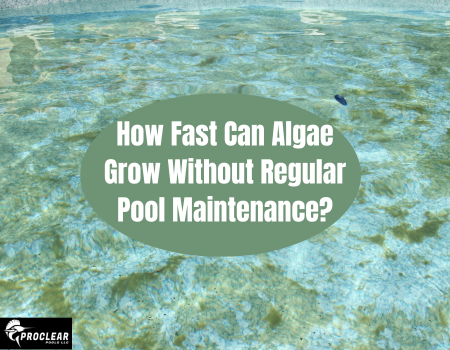There’s nothing quite like the inviting sparkle of a clean, well-maintained swimming pool. But without consistent upkeep, that sparkling blue water can quickly turn cloudy — or worse, green. One of the most common and frustrating problems pool owners face is algae growth. And if left unchecked, algae can spread shockingly fast, transforming a pristine pool into an unsightly, slimy mess in a matter of days.
So, how quickly does algae grow when regular pool maintenance is neglected? Let’s take a closer look at how algae spreads, the conditions that speed up its growth, and how you can prevent it from taking over your pool.
 What Is Pool Algae?
What Is Pool Algae?
Algae are tiny, plant-like organisms that flourish in warm, nutrient-filled water. While a small number of algae spores are always present in outdoor environments, they become a problem when the conditions in your pool allow them to multiply unchecked.
There are several types of pool algae:
- Green algae: The most common type, which turns water cloudy and green.
- Yellow (mustard) algae: A stubborn variety that clings to pool walls and floors.
- Black algae: The toughest type, forming dark, resistant spots with deep root systems.
All types of algae can be a headache for pool owners, and they grow surprisingly quickly without proper care.
How Fast Can Algae Grow in a Pool?
Under the right conditions — warm temperatures, sunlight, stagnant water, and unbalanced chemicals — algae can begin to grow in as little as 24–48 hours. Once it takes hold, a visible algae bloom can spread across your pool water and surfaces within two to three days.
This rapid growth happens because algae reproduce through simple cell division. One spore can quickly multiply into thousands, especially in summer months or during heatwaves when water temperatures soar.
Factors That Speed Up Algae Growth
Several environmental and maintenance-related factors can accelerate algae growth in your pool:
- Warm Temperatures:
Algae grow best in water temperatures ranging from 77°F to 95°F. In hot climates like Arizona, Texas, and Florida, pools can quickly reach these levels in the summer. - Unbalanced Water Chemistry:
If your chlorine levels drop below 1 ppm, it creates a window for algae to multiply. pH and alkalinity imbalances can also reduce chlorine’s effectiveness, allowing spores to survive and spread. - Poor Circulation:
Stagnant or poorly circulated water is a breeding ground for algae. Dead spots in your pool — such as behind ladders, in corners, or on steps — can encourage algae growth if water isn’t moving properly. - Organic Debris:
Leaves, pollen, dirt, and other organic material introduce nutrients into the water, providing food for algae to thrive. - Direct Sunlight:
Sunlight promotes photosynthesis in algae, accelerating its growth in sunny, exposed pools.
What Happens Without Regular Maintenance?
Without regular testing, cleaning, and chemical balancing, your pool’s defenses against algae quickly weaken. Here’s a rough timeline of how fast algae can take over:
- Day 1–2:
If chlorine levels drop or circulation stops, dormant algae spores can begin multiplying. - Day 3–4:
You might notice a slight haze or green tint to your pool water, especially in corners or along pool walls. - Day 5–7:
Without intervention, algae can fully bloom, turning the water cloudy green and covering pool surfaces with slimy patches. - Beyond 1 week:
Algae can form thick mats or stubborn black spots, requiring multiple treatments and deep cleaning to remove.
How to Prevent Algae Growth
The good news is that preventing algae is much easier than dealing with a full-blown bloom. Here’s how to keep your pool free from algae:
- Maintain Proper Chlorine Levels:
Ensure that your water is tested at least 2–3 times per week in summer to keep chlorine between 1–3 ppm. - Check pH and Alkalinity Regularly:
Ensure that pH levels are kept between 4–7.6 and total alkalinity between 80–120 ppm to help chlorine work effectively. - Run Your Pool Pump Consistently:
Circulate water for at least 8–12 hours a day in hot weather to prevent dead spots and stagnant water. - Skim and Vacuum Debris Promptly:
Remove dirt, bugs, and leaves daily to limit organic material in the pool. - Shock Your Pool Regularly:
Shocking your pool once a week during peak swim season helps kill bacteria and algae spores before they can multiply.
Algae can turn your pool from sparkling clean to swampy in as little as two to three days without regular maintenance. Warm weather, unbalanced chemicals, poor circulation, and debris all contribute to rapid algae growth.
The key to prevention is consistent care — regular testing, cleaning, and proper chemical management keep algae at bay and your pool inviting all season long. Stay proactive, and you’ll spend more time swimming and less time fighting algae.
